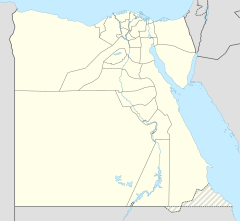Sadat Quraish Mosque
| Sadat Quraish Mosque مسجد سادات قريش | |
|---|---|
 | |
| Religion | |
| Affiliation | Islam |
| Status | Active |
| Location | |
| Location | Bilbeis, Egypt |
| Geographic coordinates | 30°25′06″N 31°33′48″E / 30.41839406619869°N 31.563449786215187°E |
| Architecture | |
| Type | mosque |
| Style | Islamic |
| Completed | 18 AH 639 CE |
The Sadat Quraish Mosque (Arabic: مسجد سادات قريش) is a historical mosque located in the city of Bilbeis, Egypt. Some historians believe it was the first mosque in Egypt and that it was founded by Amr ibn al-As in 640 CE.[1]
Naming
[edit]It was named Sadat Quraish or the Lords of the Quraysh tribe in honor of the Muslim martyrs of the Companions of the Islamic prophet Muhammad in their battle against the Romans in Belbis, where about 120 Companions were fighting of which 20-40 were martyred and buried within or around the mosque.[2]
History
[edit]Some historians have claimed that the mosque was founded during the Islamic conquest of Egypt by Amr ibn al-As on 15 Muharram 18 AH (16 January 640 CE). This would make it slightly older than the Amr ibn al-As Mosque in Fustat (modern Cairo), which is more commonly accepted as the first mosque in Egypt.[3][1][better source needed]
After the Battle of Karbala, Sayyidah Zaynab, the daughter of Ali, is said to have received a vision in Medina that the Messenger of God ordered them to take the Ahl al-Bayt (family of the Islamic prophet Muhammad) to Egypt. They were welcomed by the people of Bilbeis and stayed in the mosque for a month.[4]
The Abbasid caliph Al-Ma'mun stayed in it for 40 days when he went down to Egypt to re-establish order, after Bashmurian revolts against the Abbasid governor Isa ibn Mansur. The caliph ordered the restoration of the mosque and, as a result, it was known as the Al-Ma'mun Mosque for a period of time.[5]
The Sadat Quraish mosque is registered among the Islamic antiquities in the Ministerial Decree No. 10357 of the year 1951. It has been encroached upon by later buildings around it. Its minaret is missing its top, as it was dismantled in the 1970s due to fears of collapse.[5]
Design
[edit]The rectangular mosque contains 18 marble columns in three rows and is divided into four arches parallel to the qibla walls, and the crowns of the columns are of different shapes denoting their origin from different Ancient Egyptian and Roman temples, and the square area of the mosque is about three thousand square meters. The mosque was renovated in the Ottoman era by the Emir of Egypt, Al-Kashif, who built the minaret.[6]
References
[edit]- ^ a b "سادات قريش .. أول مسجد في مصر وأفريقيا" ["Sadat Quraish"... the first mosque in Egypt and Africa]. Aledtihad. صحيفة الاتحاد. 7 June 2017. Archived from the original on 21 June 2021.
- ^ الجريتلي, محمد (24 June 2021). "مساجد تاريخية سادات قريش ببلبيس .. مسجد أقيم لتكريم الشهداء". بوابة أخبار اليوم الإلكترونية. Archived from the original on 24 June 2021.
- ^ العراقي, ريهام (22 July 2010). "سادات قريش أول مسجد أنشئ فى مصر.. وليس جامع عمرو بن العاص" ["Sadat Quraysh" was the first mosque established in Egypt... and not the Amr bin Al-Aas Mosque]. Al-Masry al-Youm. المصري اليوم. Archived from the original on 10 July 2018.
- ^ عزالدين, محمد (15 April 2021). "علي جمعة: أهل بلبيس استقبلوا السيدة زينب عند دخولها مصر بالبكاء" [Ali Gomaa: The people of Belbeis welcomed Mrs. Zeinab when she entered Egypt with tears]. الوطن (in Arabic).
- ^ a b عبد الخالق, اسلام (26 December 2019). "سادات قريش..... أقدم مسجد في إفريقيا لم يبقى منه سوى "أطلال" مئذنته" [Sadat Quraysh...the oldest mosque in Africa, of which only the "ruins" of its minaret remain]. elmeezan.com. Archived from the original on 28 November 2020.
- ^ "سادات قريش..... أقدم مسجد في إفريقيا لم يبقى منه سوى "أطلال" مئذنته". 28 November 2020. Archived from the original on 28 November 2020.

